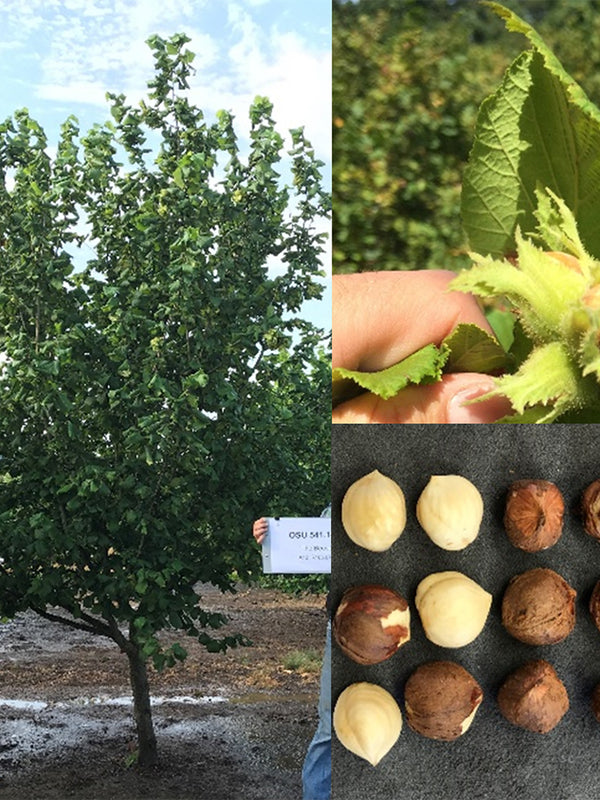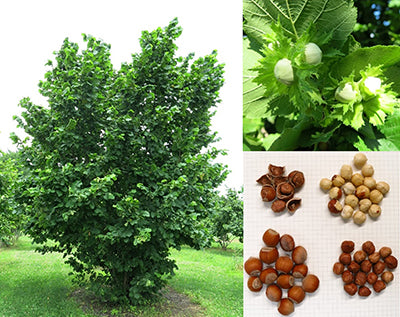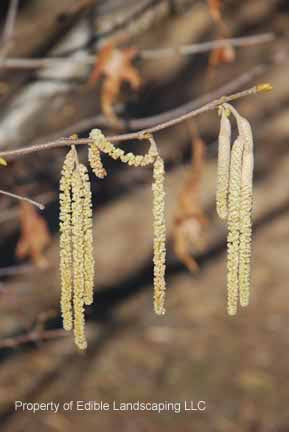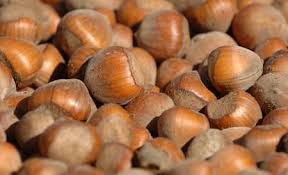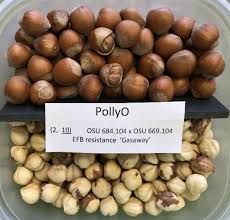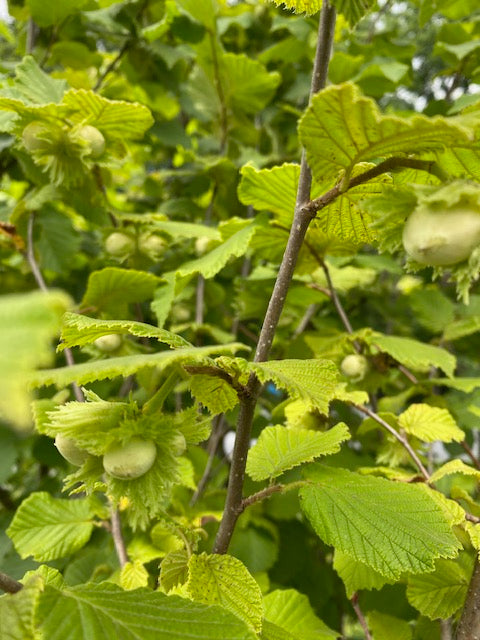
Corylus avellana x americana
Grand Traverse originated from Michigan and is reported as a cross of Faroka (F1 Turkish tree hazel [C. colurna] x European hazelnut hybrid) with the European hazelnut Royal (Farris, 1989) (note that the S-alleles do not support Royal being the pollen parent, but it appears to be European nonetheless). It is an upright, semi-vigorous tree with a slightly spreading growth habit. Grand Traverse is a 25% Turkish tree hazel hybrid, which is evident in its corky bark and elongated fingers on its nut husks. It is believed to get its EFB resistance from Faroka. Kernels are compressed and slightly pointed, very free of fiber, and have an average weight of 1.3 grams and close to 50% kernel by weight In New Jersey. It has S-alleles 11 and 25 with both expressed in the pollen, and blooms in mid-season in New Jersey. It is compatible in both directions with all of the cultivars listed above. Note that past studies at Rutgers have shown it to be resistant to EFB in New Jersey and with the pathogen collected across multiple locations (Molnar et al., 2010a). However, in 2018 a few small cankers were observed on Grand Traverse plants at Rutgers; thus, it should not be considered immune to the disease, but tolerant. This cultivar has performed well in tests in Lincoln, NE
| Plant Characteristics | |
|---|---|
| Pest Resistance | Excellent |
| Disease Resistance | Excellent |
| Drought Tolerance | Fair |
| Heat Tolerance | Excellent |
| Humidity Tolerance | Excellent |
| Sun Tolerance | Excellent |
| Wet Soil Tolerance | Poor |
| Shade Tolerance | Fair |
| No Spray | Excellent |
| Salt Tolerance | Fair |
| Fresh for Kids | Very Good |
| Deer Resistance | Fair |
| Thorns | No |
| Plant Type | Shrub |
| Soil Type | Adaptable |
| Self Fertile | No |
| This information is accurate to the best of our knowledge, comments/opinions are always welcome | |

Filbert in the winter
Filberts also called hazelnuts or hazels, filberts are deciduous shrubs 6' to 30' which produce small nuts in the fall. They grow best in zones 8 and 9 in the Northwest, but to well in 6 and 7 pretty much throughout the country. Self-unfruitful; plant at least two varieties.
Culture
Plant filberts in a spot protected from bitter winter winds. The plants do not have tap roots, but put down very deep roots. They should have a deep, well drained, fertile, humus soil. In colder climates, where plants don't grow as large they need a space only 10 to 12' across.
Because filberts are small trees, it is more practical to mulch then than larger nut trees. Use hay, leaves, or other organic material. The nutrients the mulch contributes to the soil is important to maintain of vigorous growth and good nut production. Further to promote growth, you should fertilize the plants with a balanced fertilizer such as 20-10-10. Apply 1/2 cup after the young plants are making growth; 1 cup the next year; and from then on increase the dosage by 1 cup a year until you reach 6. This is about the maximum for cold climates; but in milder areas, you can increase the supply 30 to 50%.
Filberts start to bear two or three years after they are planted. They reach good production three or four years later, but are likely to become erratic after ten years unless they are pruned severely.
Nuts are harvested from the ground after they drop. If the husks remain, these must be removed. The nuts should then be spread out in a warm dry, shady place to dry.
| Cultivar |
suggested Pollinizers |
Also compatible |
| Jefferson |
Feilx, Eta, Theta, Yamhill |
Flowers to late for other pollination |
| Dorris |
York, Felix |
Yamhill, Gama McDonald |
| Wepster |
McDonald, York, Jefferson |
Yamhill, Felix |
| Yamhill |
York, Dorris, Wepster, Jefferson |
Gamma, Epsilon |
| Sacajawea |
McDonald, York, Felix |
Yamhill, Lewis, Gamma |
| McDoanld |
Wepster, York, Jefferson |
Yamhill, Sacajawea |
| Barcelona |
Gamma, Felix, York |

